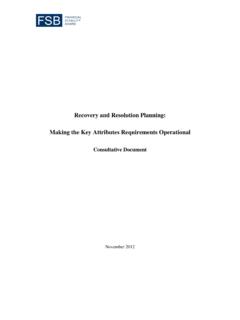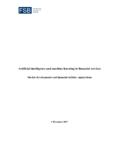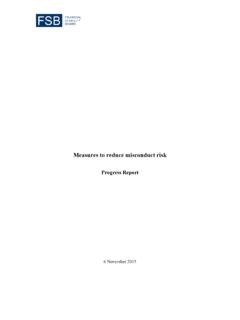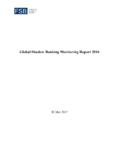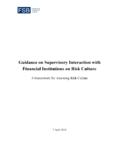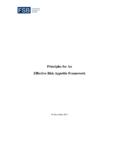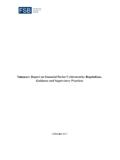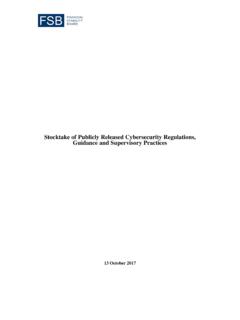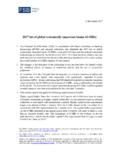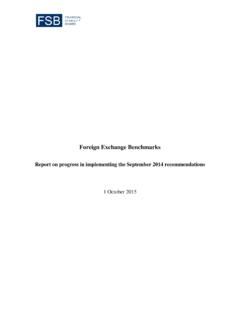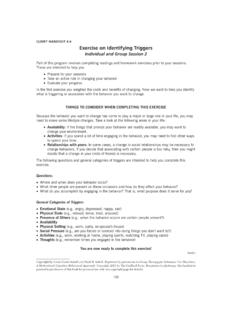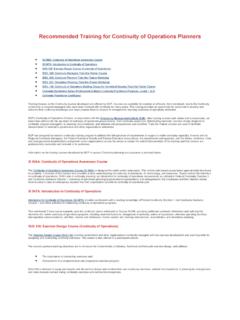Transcription of Guiding Principles on the Internal Total Loss …
1 Guiding Principles on the Internal Total loss - absorbing capacity of G-SIBs ( Internal TLAC'). 6 July 2017. The Financial Stability Board (FSB) is established to coordinate at the international level the work of national financial authorities and international standard-setting bodies in order to develop and promote the implementation of effective regulatory, supervisory and other financial sector policies. Its mandate is set out in the FSB Charter, which governs the policymaking and related activities of the FSB. These activities, including any decisions reached in their context, shall not be binding or give rise to any legal rights or obligations under the FSB's Articles of Association.
2 Contacting the Financial Stability Board Sign up for e-mail alerts: Follow the FSB on Twitter: @FinStbBoard E-mail the FSB at: Copyright 2017 Financial Stability Board. Please refer to: ii Table of Contents Page Overview .. 1. I. Material sub-group identification and composition .. 3. Guiding Principle 1: Material sub-group identification .. 3. Guiding Principle 2: Material sub-group composition and distribution of Internal TLAC 4. Guiding Principle 3: Multi-jurisdictional material sub-groups .. 5. Guiding Principle 4: Regulated or unregulated non-bank entities .. 6. II. Size of the Internal TLAC requirement.
3 7. Guiding Principle 5: The role of the host 7. Guiding Principle 6: The role of the home authority .. 8. Guiding Principle 7: Surplus TLAC .. 9. III. Composition and issuance of Internal TLAC .. 10. Guiding Principle 8: Internal TLAC composition .. 10. Guiding Principle 9: Collateralised guarantees .. 11. Guiding Principle 10: Internal TLAC issuance .. 13. Guiding Principle 11: Internal TLAC governing law .. 14. Guiding Principle 12: Internal TLAC obstacles .. 14. IV. Features of trigger mechanisms for Internal TLAC .. 15. Guiding Principle 13: Trigger conditions .. 15. V. The home-host process for triggering Internal TLAC.
4 16. Stage 1 Home and host communication prior to triggering Internal TLAC .. 16. Guiding Principle 14: Home and host 16. Guiding Principle 15: Options to restore material sub-group viability .. 16. Stage 2 Determination to trigger Internal TLAC .. 17. Guiding Principle 16: Triggering Internal TLAC .. 17. Guiding Principle 17: Home authority consent .. 18. Stage 3 Write-down and/or conversion of Internal 19. Guiding Principle 18: Material sub-group 19. Guiding Principle 19: Choice of write-down or conversion into equity .. 19. Guiding Principle 20: Conformance 20. Annex 1 Examples of material sub-group 22.
5 Annex 2 Example of a possible Internal TLAC deduction approach .. 23. Annex 3 Example contractual trigger for Internal TLAC .. 24. Annex 4 TLAC Term Sheet Sections 16-19 .. 26. iii iv Guiding Principles on the Internal Total loss - absorbing capacity of G-SIBs ( Internal TLAC'). Overview In November 2015 the FSB, in consultation with the Basel Committee on Banking Supervision (BCBS), finalised and agreed a new standard on the adequacy of Total loss - absorbing capacity for Global Systemically Important Banks (G-SIBs) in resolution ( the TLAC standard'). 1 The TLAC standard comprises a set of Principles on the loss - absorbing and recapitalisation capacity of G-SIBs in resolution, and a term sheet that implements those Principles .
6 A key objective of the TLAC standard is to provide home and host authorities with confidence that G-SIBs can be resolved in an orderly manner without putting public funds at risk. This should diminish any incentives on the part of host authorities to ring-fence assets domestically, either ex ante or ex post in a resolution, and thereby avoid the adverse consequences of such actions, including global fragmentation of the financial system, and disorderly resolutions of failed cross-border firms. Principle (vi) of the TLAC standard states that host authorities must have confidence that there is sufficient loss - absorbing and recapitalisation capacity available to subsidiaries in their jurisdictions with legal certainty at the point of entry into resolution.
7 To this end, there must be sufficient flexibility to use loss - absorbing capacity within a G-SIB where needed and credible mechanisms in place to allow losses and recapitalisation needs to be passed with legal certainty to the resolution entity or entities. A resolution entity should act as a source of loss - absorbing and recapitalisation capacity for its subsidiaries where those subsidiaries are not themselves resolution entities. 2. Internal TLAC is the loss - absorbing capacity that resolution entities have committed to material sub-groups. It provides for a mechanism whereby losses and recapitalisation needs of material sub-groups may be passed with legal certainty to the resolution entity of a G-SIB resolution group, without entry into resolution of the subsidiaries within the material sub-group.
8 A material sub-group consists of an individual subsidiary or a group of subsidiaries that are not themselves resolution entities and that, on a solo or sub-consolidated basis, meet certain 1. See Principles on loss - absorbing and Recapitalisation of G-SIBs in Resolution and Total loss - absorbing capacity (TLAC) Term Sheet ( ), November 2015. 2. A resolution entity is an entity to which resolution tools will be applied in accordance with the resolution strategy for the G-SIB. A G-SIB may have one or more resolution entities, depending on whether the resolution strategy is based on a single point of entry' resolution, in which resolution powers are applied to the top of a group by a single resolution authority, or a multiple point of entry resolution' in which resolution tools are applied to different parts of the group by two or more resolution authorities acting in a coordinated way.
9 See Recovery and Resolution Planning for Systemically Important Financial Institutions: Guidance on Developing Effective Resolution Strategies ( content/ ), July 2013. 1. quantitative criteria specified in Section 17 of the TLAC term sheet, or are identified by a firm's Crisis Management Group (CMG) as material to the exercise of the firm's critical functions. 3. Under Section 18 of the TLAC term sheet, each material sub-group must maintain Internal TLAC of 75% - 90% of the external Minimum TLAC requirement that would apply to the material sub-group if it were itself a resolution group. The actual requirement in that range is to be determined by the relevant host authority in consultation with the home authority.
10 The triggering of Internal TLAC at the point of non-viability by the host authority (subject to home authority consent, where required) passes losses and recapitalisation needs of entities within the material sub-group to the resolution entity, without entry into resolution of the subsidiaries within the material sub-group. While the TLAC term sheet sets out the core features of Internal TLAC in relation to quantum, triggers and eligibility of instruments, CMG authorities will need to consider a number of technical and practical issues as they develop and implement Internal TLAC mechanisms. This document sets out high-level Guiding Principles to assist CMG authorities in the implementation of Internal TLAC mechanisms consistent with the TLAC standard.
